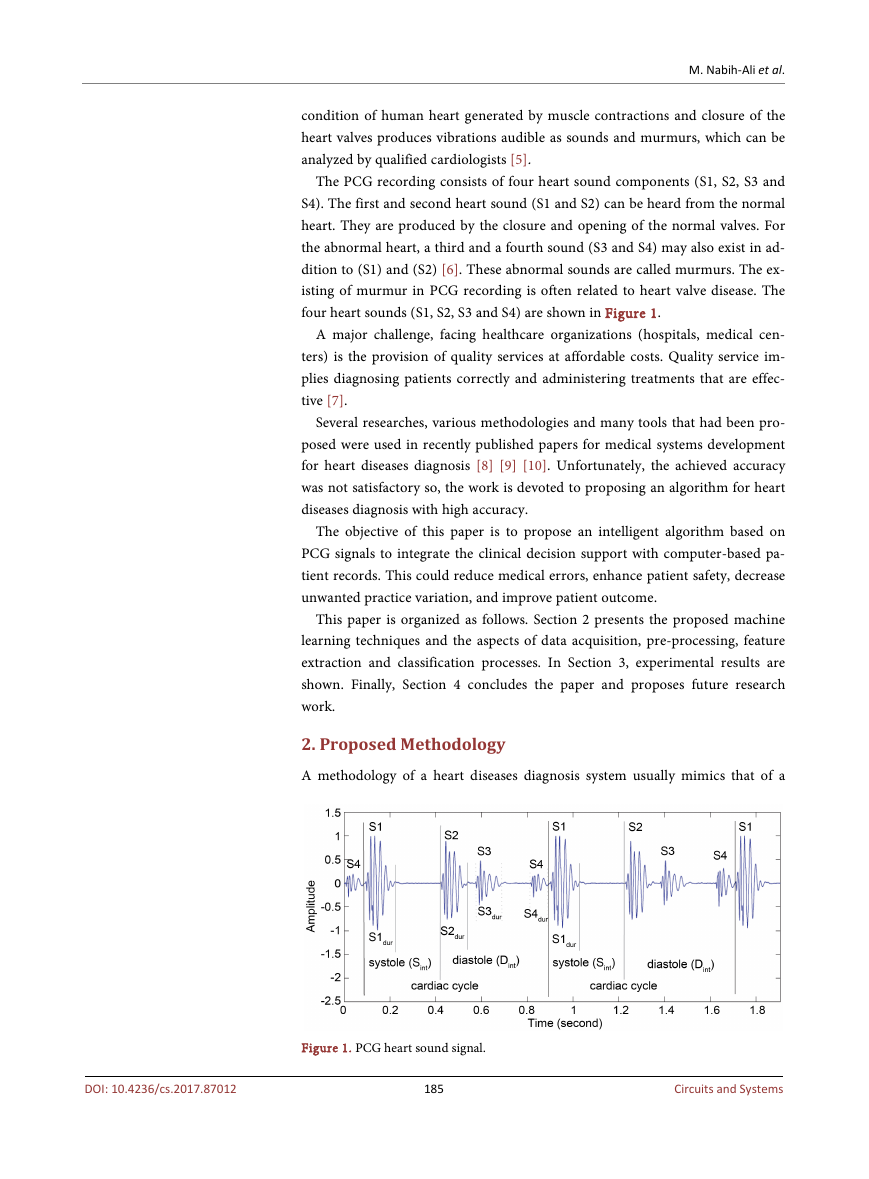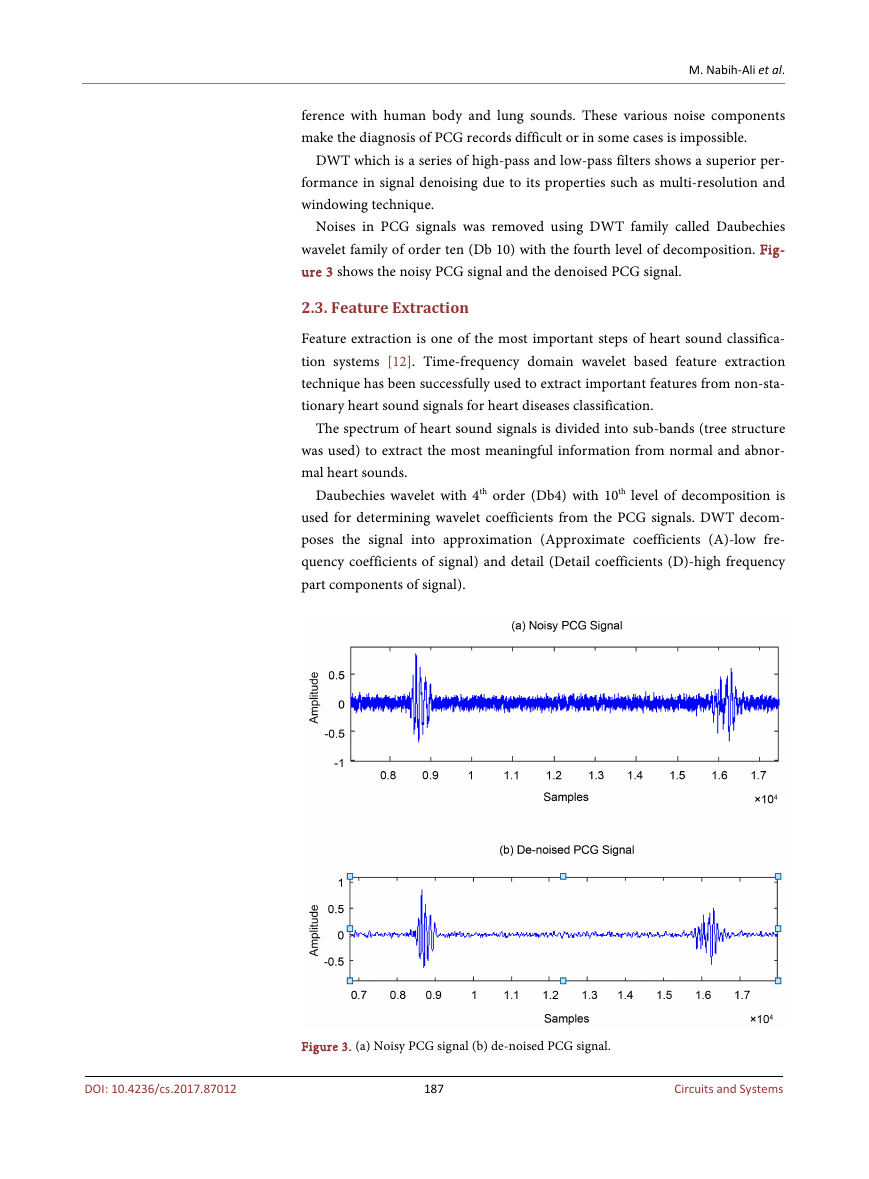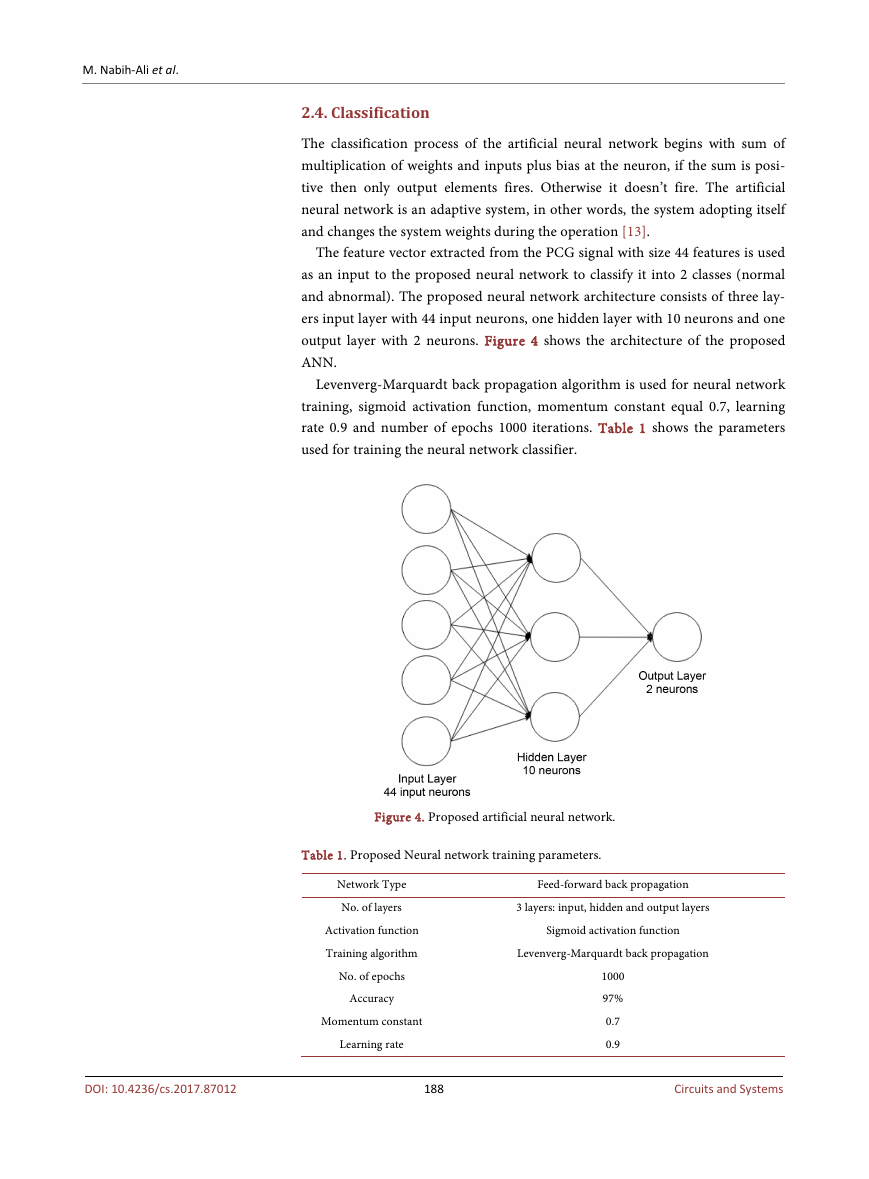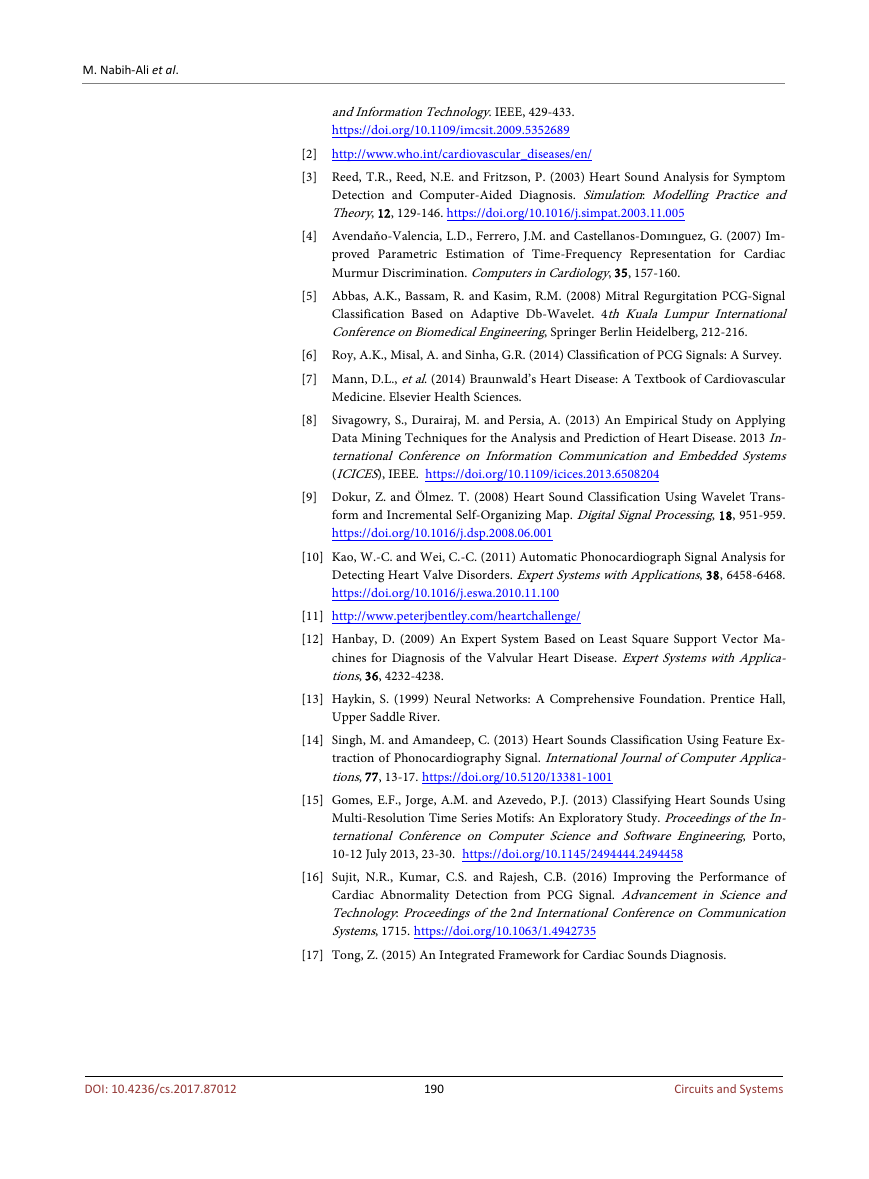Circuits and Systems, 2017, 8, 184-190
http://www.scirp.org/journal/cs
ISSN Online: 2153-1293
ISSN Print: 2153-1285
Heart Diseases Diagnosis Using Intelligent
Algorithm Based on PCG Signal Analysis
Mohammed Nabih-Ali1, El-Sayed A. El-Dahshan1,2, Ashraf S. Yahia2
1Faculty of Computer and Information Technology, Egyptian E-Learning University (EELU), Giza, Egypt
2Physics Department, Faculty of Sciences, Ain Shams University, Cairo, Egypt
How to cite this paper: Nabih-Ali, M.,
El-Dahshan, E.-S.A. and Yahia, A.S. (2017)
Heart Diseases Diagnosis Using Intelligent
Algorithm Based on PCG Signal Analysis.
Circuits and Systems, 8, 184-190.
https://doi.org/10.4236/cs.2017.87012
Received: January 12, 2017
Accepted: July 25, 2017
Published: July 28, 2017
Copyright © 2017 by authors and
Scientific Research Publishing Inc.
This work is licensed under the Creative
Commons Attribution International
License (CC BY 4.0).
http://creativecommons.org/licenses/by/4.0/
Open Access
Abstract
This paper presents an intelligent algorithm for heart diseases diagnosis using
phonocardiogram (PCG). The proposed technique consists of four stages:
Data acquisition, pre-processing, feature extraction and classification. PASCAL
heart sound database is used in this research. The second stage concerns with
removing noise and artifacts from the PCG signals. Feature extraction stage is
carried out using discrete wavelet transform (DWT). Finally, artificial neural
network (ANN) has been used for classification stage with an overall accuracy
97%.
Keywords
Heart Diseases, Phonocardiogram (PCG), Feature Extraction, Discrete
Wavelet Transform (DWT), Artificial Neural Network (ANN)
1. Introduction
Cardiovascular disorders (CVDs) or Heart diseases are broad terms that can af-
fect both vasculature and the heart muscle itself [1]. CVDs remains the first
cause of mortality globally, responsible for 17.5 million people dying annually [2].
More than 75% of CVDs deaths occur in middle and low income countries [2].
The heart sounds are still the primary tool for screening and diagnosing many
pathological conditions of the human heart. Using auscultation technique which
was invented and defined by Laennec for heart sound analysis is still insufficient.
The reason of insufficiency is reported by Avendano-Valencia et al., [3] [4] due
to the human ear limitation and subjective of the analyst and the discriminatory
skills that can take many years to acquire.
Phonocardiography (PCG) is one of non-invasive techniques to diagnose
DOI: 10.4236/cs.2017.87012 Jul. 28, 2017
184
Circuits and Systems
�
M. Nabih-Ali et al.
condition of human heart generated by muscle contractions and closure of the
heart valves produces vibrations audible as sounds and murmurs, which can be
analyzed by qualified cardiologists [5].
The PCG recording consists of four heart sound components (S1, S2, S3 and
S4). The first and second heart sound (S1 and S2) can be heard from the normal
heart. They are produced by the closure and opening of the normal valves. For
the abnormal heart, a third and a fourth sound (S3 and S4) may also exist in ad-
dition to (S1) and (S2) [6]. These abnormal sounds are called murmurs. The ex-
isting of murmur in PCG recording is often related to heart valve disease. The
four heart sounds (S1, S2, S3 and S4) are shown in Figure 1.
A major challenge, facing healthcare organizations (hospitals, medical cen-
ters) is the provision of quality services at affordable costs. Quality service im-
plies diagnosing patients correctly and administering treatments that are effec-
tive [7].
Several researches, various methodologies and many tools that had been pro-
posed were used in recently published papers for medical systems development
for heart diseases diagnosis [8] [9] [10]. Unfortunately, the achieved accuracy
was not satisfactory so, the work is devoted to proposing an algorithm for heart
diseases diagnosis with high accuracy.
The objective of this paper is to propose an intelligent algorithm based on
PCG signals to integrate the clinical decision support with computer-based pa-
tient records. This could reduce medical errors, enhance patient safety, decrease
unwanted practice variation, and improve patient outcome.
This paper is organized as follows. Section 2 presents the proposed machine
learning techniques and the aspects of data acquisition, pre-processing, feature
extraction and classification processes. In Section 3, experimental results are
shown. Finally, Section 4 concludes the paper and proposes future research
work.
2. Proposed Methodology
A methodology of a heart diseases diagnosis system usually mimics that of a
DOI: 10.4236/cs.2017.87012
Figure 1. PCG heart sound signal.
185
Circuits and Systems
�
M. Nabih-Ali et al.
pattern recognition system. Thus, it can be broken down into four main pro-
cesses, namely; 1) data acquisition, 2) pre-processing; 3) feature extraction and
4) classification (subject identification). Figure 2 shows the proposed metho-
dology for heart diseases diagnosis. In the following subsection each stage will be
discussed.
The experiments were carried out on the platform of core i3 with 3 G memory
running under windows 10 64 bit. The proposed algorithms were developed us-
ing MATLAB 2014b wavelet toolbox.
2.1. Data Acquisition
Datasets were collected from PASCAL heart sound database [11]. A data base of
170 heart sound signals was created and divided into 121 signals (24 normal
signals and 97 abnormal signals) for training and 49 signals (10 normal signals
and 39 abnormal signals).
The acoustic audio files have varying lengths, between 1 second and 30
seconds. Mainly the most information in heart sounds is enclosed in the low
frequency components, having noise in the higher frequencies.
2.2. Signal Pre-Processing
PCG signals usually suffers from noise like electromagnetic interference from
surrounding environment, power frequency interference, electrical signal inter-
DOI: 10.4236/cs.2017.87012
Figure 2. Proposed methodology.
186
Circuits and Systems
�
M. Nabih-Ali et al.
ference with human body and lung sounds. These various noise components
make the diagnosis of PCG records difficult or in some cases is impossible.
DWT which is a series of high-pass and low-pass filters shows a superior per-
formance in signal denoising due to its properties such as multi-resolution and
windowing technique.
Noises in PCG signals was removed using DWT family called Daubechies
wavelet family of order ten (Db 10) with the fourth level of decomposition. Fig-
ure 3 shows the noisy PCG signal and the denoised PCG signal.
2.3. Feature Extraction
Feature extraction is one of the most important steps of heart sound classifica-
tion systems [12]. Time-frequency domain wavelet based feature extraction
technique has been successfully used to extract important features from non-sta-
tionary heart sound signals for heart diseases classification.
The spectrum of heart sound signals is divided into sub-bands (tree structure
was used) to extract the most meaningful information from normal and abnor-
mal heart sounds.
Daubechies wavelet with 4th order (Db4) with 10th level of decomposition is
used for determining wavelet coefficients from the PCG signals. DWT decom-
poses the signal into approximation (Approximate coefficients (A)-low fre-
quency coefficients of signal) and detail (Detail coefficients (D)-high frequency
part components of signal).
DOI: 10.4236/cs.2017.87012
Figure 3. (a) Noisy PCG signal (b) de-noised PCG signal.
187
Circuits and Systems
�
M. Nabih-Ali et al.
2.4. Classification
The classification process of the artificial neural network begins with sum of
multiplication of weights and inputs plus bias at the neuron, if the sum is posi-
tive then only output elements fires. Otherwise it doesn’t fire. The artificial
neural network is an adaptive system, in other words, the system adopting itself
and changes the system weights during the operation [13].
The feature vector extracted from the PCG signal with size 44 features is used
as an input to the proposed neural network to classify it into 2 classes (normal
and abnormal). The proposed neural network architecture consists of three lay-
ers input layer with 44 input neurons, one hidden layer with 10 neurons and one
output layer with 2 neurons. Figure 4 shows the architecture of the proposed
ANN.
Levenverg-Marquardt back propagation algorithm is used for neural network
training, sigmoid activation function, momentum constant equal 0.7, learning
rate 0.9 and number of epochs 1000 iterations. Table 1 shows the parameters
used for training the neural network classifier.
Figure 4. Proposed artificial neural network.
Table 1. Proposed Neural network training parameters.
Network Type
No. of layers
Activation function
Training algorithm
No. of epochs
Accuracy
Momentum constant
Learning rate
Feed-forward back propagation
3 layers: input, hidden and output layers
Sigmoid activation function
Levenverg-Marquardt back propagation
1000
97%
0.7
0.9
DOI: 10.4236/cs.2017.87012
188
Circuits and Systems
�
M. Nabih-Ali et al.
Table 2. Comparison between our proposed methodology and previous proposed me-
thodologies.
Author
Database
Methods
Mandeep Singh
(2013) [14]
Elsa Ferreira
(2013) [15]
N. R. Sujit
(2016) [16]
Zichun Tong
(2015) [17]
PASCAL dataset
Naїve Bayes classifier
PASCAL
dataset
PASCAL
dataset
PASCAL
dataset
Decision tree classification
algorithm
Regression Tree
Hilbert Transform + Support
vector machine
Our proposed System
PASCAL dataset
DWT and ANN
Results
Accuracy
93.33%
Accuracy
72.76%
Accuracy
78.33%
Accuracy
90.5%
Accuracy
97%
For 170 heart sound signals was created and divided into 121 signals (24 nor-
mal signals and 97 abnormal signals) for training and 49 signals (10 normal sig-
nals and 39 abnormal signals) the neural network classifier misclassified one
signal achieving an accuracy of 97%.
Finally, Table 2 shows a comparison between our proposed algorithm results
with the previous methodologies results to see the efficiency of the proposed
methodology.
From Table 2, it is clear that our proposed algorithm reached better classifica-
tion accuracy than the compared studies.
3. Conclusions
This paper proposed an algorithm for heart diseases diagnosis based on PCG
signals. The proposed algorithm consists of four stages: Data acquisition, pre-
processing, feature extraction and classification. PASCAL PCG signal database
was used for training and testing the proposed algorithm. We applied DWT in
noise elimination and feature extraction stages and neural network is used for
PCG signals classification. A feature vector of size 44 features is formed using
DWT used as an input to the classifier for training and testing. ANN is trained
using the obtained features. The results showed accuracy of 97% for PASCAL
heart sound database.
Despite the high accuracy obtained, the system still has some drawbacks like
using small dataset, existence of low energy events or noise and the limitation of
classifier used for detecting and diagnosis of heart diseases can affect on the di-
agnosing accuracy. In the future work we can mention that working towards
hybrid techniques which hybrids more than one classification techniques to
achieve more accurate results.
References
[1] Salem, A.-B.M., Revett, K. and El-Dahshan, E.-S.A. (2009) Machine learning in
electrocardiogram diagnosis. International Multiconference on Computer Science
189
Circuits and Systems
DOI: 10.4236/cs.2017.87012
�
M. Nabih-Ali et al.
DOI: 10.4236/cs.2017.87012
and Information Technology. IEEE, 429-433.
https://doi.org/10.1109/imcsit.2009.5352689
[2] http://www.who.int/cardiovascular_diseases/en/
[3] Reed, T.R., Reed, N.E. and Fritzson, P. (2003) Heart Sound Analysis for Symptom
Detection and Computer-Aided Diagnosis. Simulation: Modelling Practice and
Theory, 12, 129-146. https://doi.org/10.1016/j.simpat.2003.11.005
[4] Avendaňo-Valencia, L.D., Ferrero, J.M. and Castellanos-Domınguez, G. (2007) Im-
proved Parametric Estimation of Time-Frequency Representation for Cardiac
Murmur Discrimination. Computers in Cardiology, 35, 157-160.
[5] Abbas, A.K., Bassam, R. and Kasim, R.M. (2008) Mitral Regurgitation PCG-Signal
Classification Based on Adaptive Db-Wavelet. 4th Kuala Lumpur International
Conference on Biomedical Engineering, Springer Berlin Heidelberg, 212-216.
[6] Roy, A.K., Misal, A. and Sinha, G.R. (2014) Classification of PCG Signals: A Survey.
[7] Mann, D.L., et al. (2014) Braunwald’s Heart Disease: A Textbook of Cardiovascular
Medicine. Elsevier Health Sciences.
[8] Sivagowry, S., Durairaj, M. and Persia, A. (2013) An Empirical Study on Applying
Data Mining Techniques for the Analysis and Prediction of Heart Disease. 2013 In-
ternational Conference on Information Communication and Embedded Systems
(ICICES), IEEE. https://doi.org/10.1109/icices.2013.6508204
[9] Dokur, Z. and Ölmez. T. (2008) Heart Sound Classification Using Wavelet Trans-
form and Incremental Self-Organizing Map. Digital Signal Processing, 18, 951-959.
https://doi.org/10.1016/j.dsp.2008.06.001
[10] Kao, W.-C. and Wei, C.-C. (2011) Automatic Phonocardiograph Signal Analysis for
Detecting Heart Valve Disorders. Expert Systems with Applications, 38, 6458-6468.
https://doi.org/10.1016/j.eswa.2010.11.100
[11] http://www.peterjbentley.com/heartchallenge/
[12] Hanbay, D. (2009) An Expert System Based on Least Square Support Vector Ma-
chines for Diagnosis of the Valvular Heart Disease. Expert Systems with Applica-
tions, 36, 4232-4238.
[13] Haykin, S. (1999) Neural Networks: A Comprehensive Foundation. Prentice Hall,
Upper Saddle River.
[14] Singh, M. and Amandeep, C. (2013) Heart Sounds Classification Using Feature Ex-
traction of Phonocardiography Signal. International Journal of Computer Applica-
tions, 77, 13-17. https://doi.org/10.5120/13381-1001
[15] Gomes, E.F., Jorge, A.M. and Azevedo, P.J. (2013) Classifying Heart Sounds Using
Multi-Resolution Time Series Motifs: An Exploratory Study. Proceedings of the In-
ternational Conference on Computer Science and Software Engineering, Porto,
10-12 July 2013, 23-30. https://doi.org/10.1145/2494444.2494458
[16] Sujit, N.R., Kumar, C.S. and Rajesh, C.B. (2016) Improving the Performance of
Cardiac Abnormality Detection from PCG Signal. Advancement in Science and
Technology: Proceedings of the 2nd International Conference on Communication
Systems, 1715. https://doi.org/10.1063/1.4942735
[17] Tong, Z. (2015) An Integrated Framework for Cardiac Sounds Diagnosis.
190
Circuits and Systems
�
Submit or recommend next manuscript to SCIRP and we will provide best
service for you:
Accepting pre-submission inquiries through Email, Facebook, LinkedIn, Twitter, etc.
A wide selection of journals (inclusive of 9 subjects, more than 200 journals)
Providing 24-hour high-quality service
User-friendly online submission system
Fair and swift peer-review system
Efficient typesetting and proofreading procedure
Display of the result of downloads and visits, as well as the number of cited articles
Maximum dissemination of your research work
Submit your manuscript at: http://papersubmission.scirp.org/
Or contact cs@scirp.org
�
















 2023年江西萍乡中考道德与法治真题及答案.doc
2023年江西萍乡中考道德与法治真题及答案.doc 2012年重庆南川中考生物真题及答案.doc
2012年重庆南川中考生物真题及答案.doc 2013年江西师范大学地理学综合及文艺理论基础考研真题.doc
2013年江西师范大学地理学综合及文艺理论基础考研真题.doc 2020年四川甘孜小升初语文真题及答案I卷.doc
2020年四川甘孜小升初语文真题及答案I卷.doc 2020年注册岩土工程师专业基础考试真题及答案.doc
2020年注册岩土工程师专业基础考试真题及答案.doc 2023-2024学年福建省厦门市九年级上学期数学月考试题及答案.doc
2023-2024学年福建省厦门市九年级上学期数学月考试题及答案.doc 2021-2022学年辽宁省沈阳市大东区九年级上学期语文期末试题及答案.doc
2021-2022学年辽宁省沈阳市大东区九年级上学期语文期末试题及答案.doc 2022-2023学年北京东城区初三第一学期物理期末试卷及答案.doc
2022-2023学年北京东城区初三第一学期物理期末试卷及答案.doc 2018上半年江西教师资格初中地理学科知识与教学能力真题及答案.doc
2018上半年江西教师资格初中地理学科知识与教学能力真题及答案.doc 2012年河北国家公务员申论考试真题及答案-省级.doc
2012年河北国家公务员申论考试真题及答案-省级.doc 2020-2021学年江苏省扬州市江都区邵樊片九年级上学期数学第一次质量检测试题及答案.doc
2020-2021学年江苏省扬州市江都区邵樊片九年级上学期数学第一次质量检测试题及答案.doc 2022下半年黑龙江教师资格证中学综合素质真题及答案.doc
2022下半年黑龙江教师资格证中学综合素质真题及答案.doc